Taxonomy
Taxonomy is an important discipline that sets the foundation for a significant part of biological research, yet it is often undervalued and the number of taxonomists is decreasing. This is not only true for extant biology, but also for palaeontology. Taxonomic names are usually not listed in CV’s, although the author’s names are an integral part of them. So I think this website is a good place to list all the taxa where I have been involved in naming and describing them.
I list all taxa where I contributed in their first description in chronological order (even if my own part was only small in some cases). All taxa are provided with a very brief characterisation, including its age, provenance and link to the corresponding publication.
Note that taxonomy is an organic discipline, meaning that names may change or become invalidated by future work, though I will try to update this list as best as possible.
Images are taken from the publication containing the original description of the taxon, unless noted otherwise.
Family level and above
- Pseudoalveolata Stevens, Pohle, Hoffmann & Immenhauser, 2023 (unranked)
A clade of Cretaceous belemnites (Coleoidea, Cephalopoda) that is characterised by the presence of a primarily porous and organic-rich structure in the anterior part of the rostrum (pseudoalveolus). Comprises the Belemnitellidae, Dimitobelidae and a few others. Link
Genera
Mesonaedyceras Pohle & Klug, 2018
A Middle Devonian member of the Naedyceratidae (Oncoceratida, Multiceratoidea, Cephalopoda) that shows asymmetric septa. LinkSubtheoceras Pohle & Klug, 2018
A small Early Devonian representative of the Orthoceratidae (Orthoceratida, Orthoceratoidea, Cephalopoda) that shows minute incisions or striae on its conch surface. LinkBasiloceras Pohle, Klug & Haas, 2019
A Middle Devonian acleistoceratid (Oncoceratida, Multiceratoidea, Cephalopoda) that comprises two species with a large size range (see below). Link
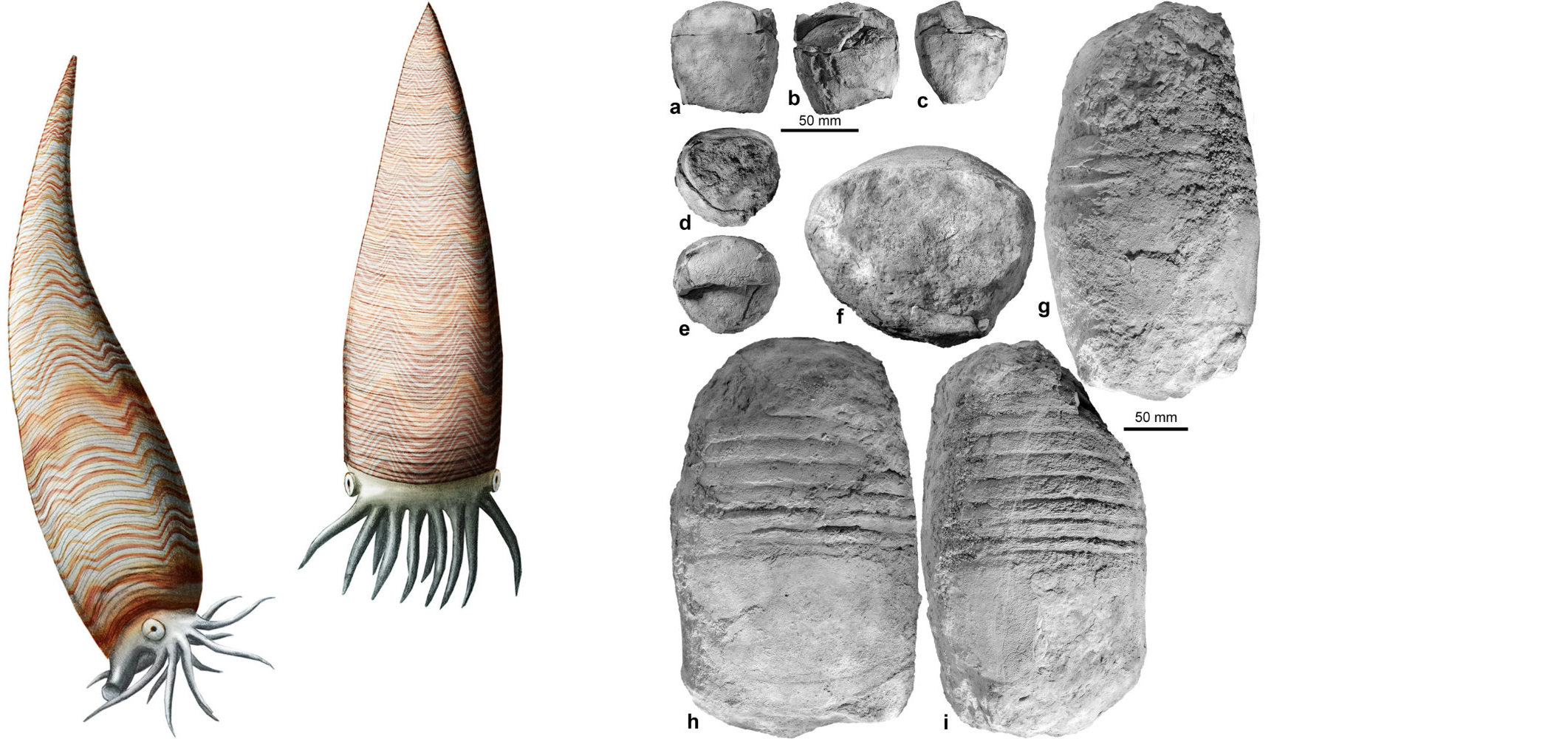
Source: Pohle et al. 2019, Swiss Journal of Palaeontology.Ethanoceras Kröger & Pohle, 2021
An Early Ordovician taxon of the Rioceratidae (Rioceratida, Orthoceratoidea, Cephalopoda) that differs from most other early orthoceratoids by having a non-marginal siphuncle. Link

Source: Kröger & Pohle 2021, European Journal of Taxonomy.Hinlopoceras Kröger & Pohle, 2021
Another Early Ordovician rioceratid (Rioceratida, Orthoceratoidea, Cephalopoda), with a relatively high expansion rate and distinct transverse bands or striae. Link
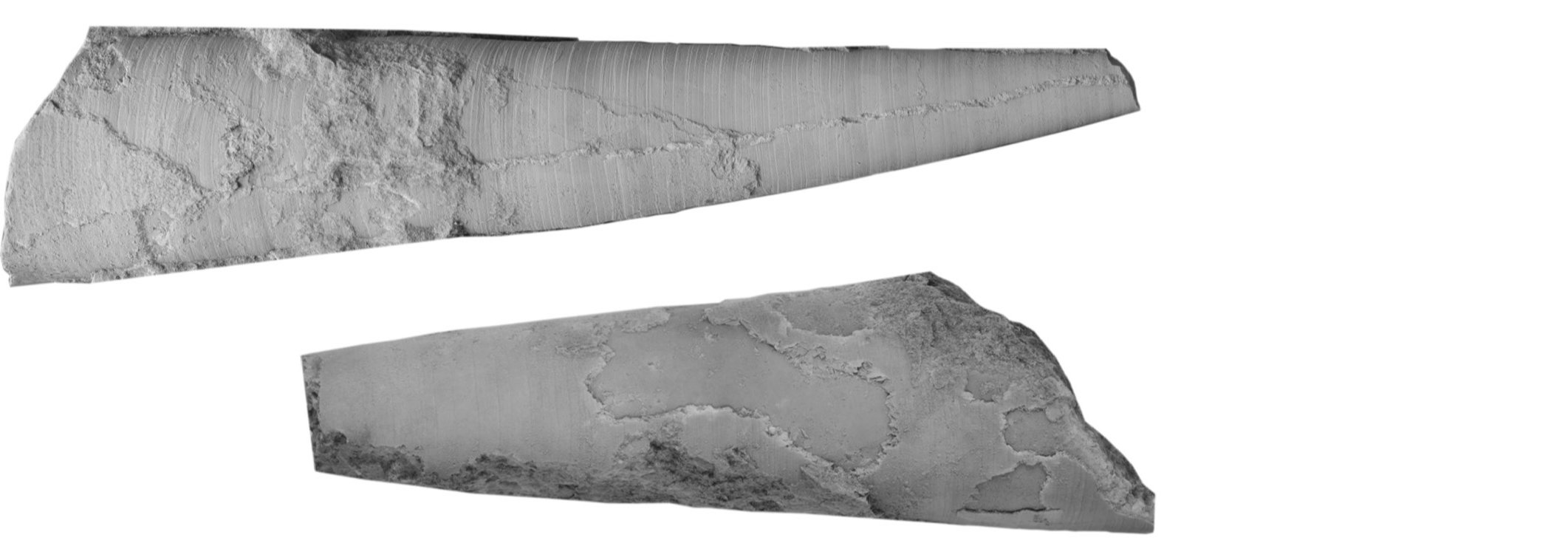
Source: Kröger & Pohle 2021, European Journal of Taxonomy.Nyfrieslandoceras Kröger & Pohle, 2021
A taxon intermediate between bassleroceratids and oncoceratids, belonging to the family Phthanoncoceratidae (Oncoceratida, Multiceratoidea, Cephalopoda) from the Early Ordovician. Link
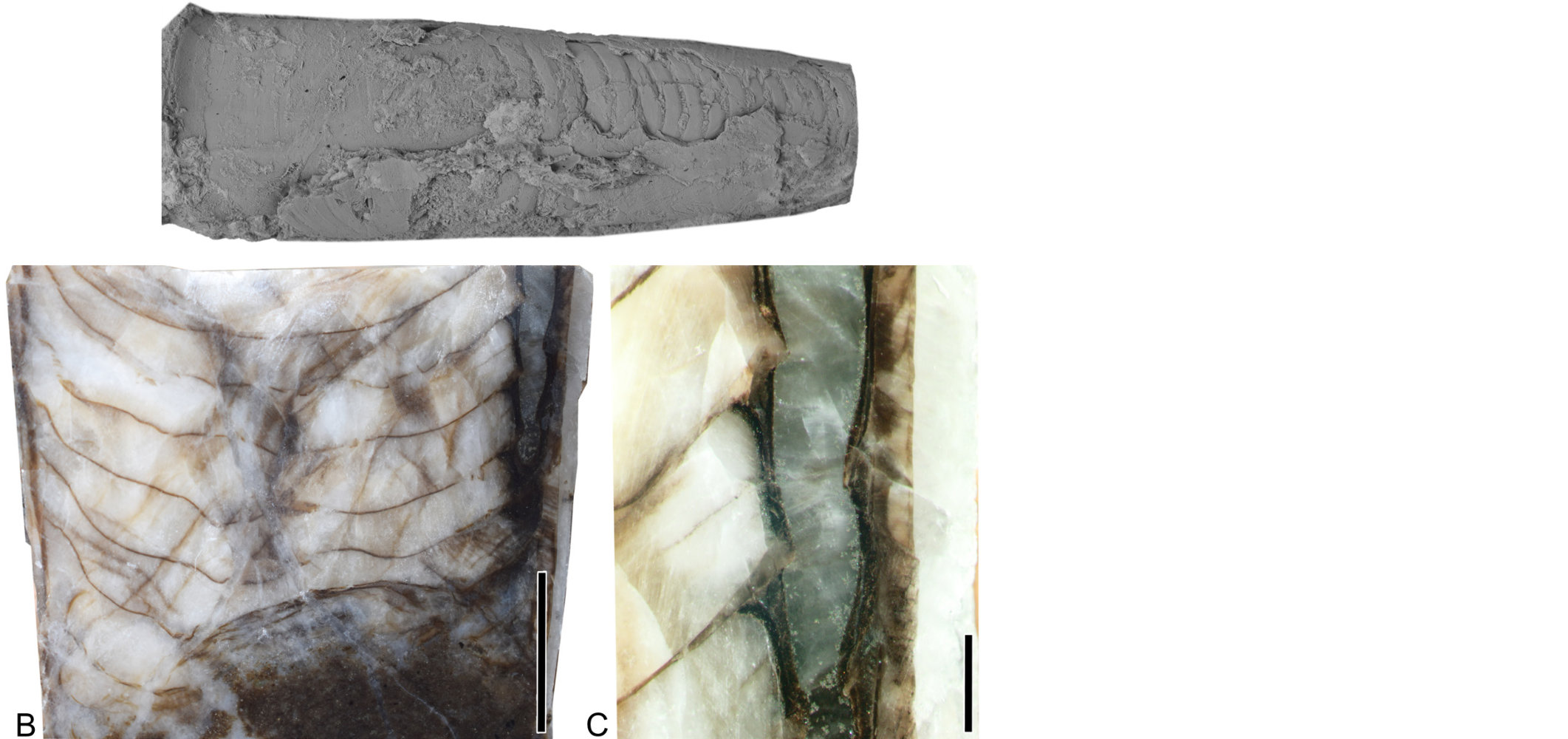
Source: Kröger & Pohle 2021, European Journal of Taxonomy.Olenidslettoceras Kröger & Pohle, 2021
As above, this is an Early Ordovician phthanoncoceratid (Oncoceratida, Multiceratoidea, Cephalopoda), with characteristic septal necks. Link

Source: Kröger & Pohle 2021, European Journal of Taxonomy.Svalbardoceras Kröger & Pohle, 2021
A slightly curved annulated rioceratid (Rioceratida, Multiceratoidea, Cephalopoda) with widely spaced septa from the Early Ordovician. Link
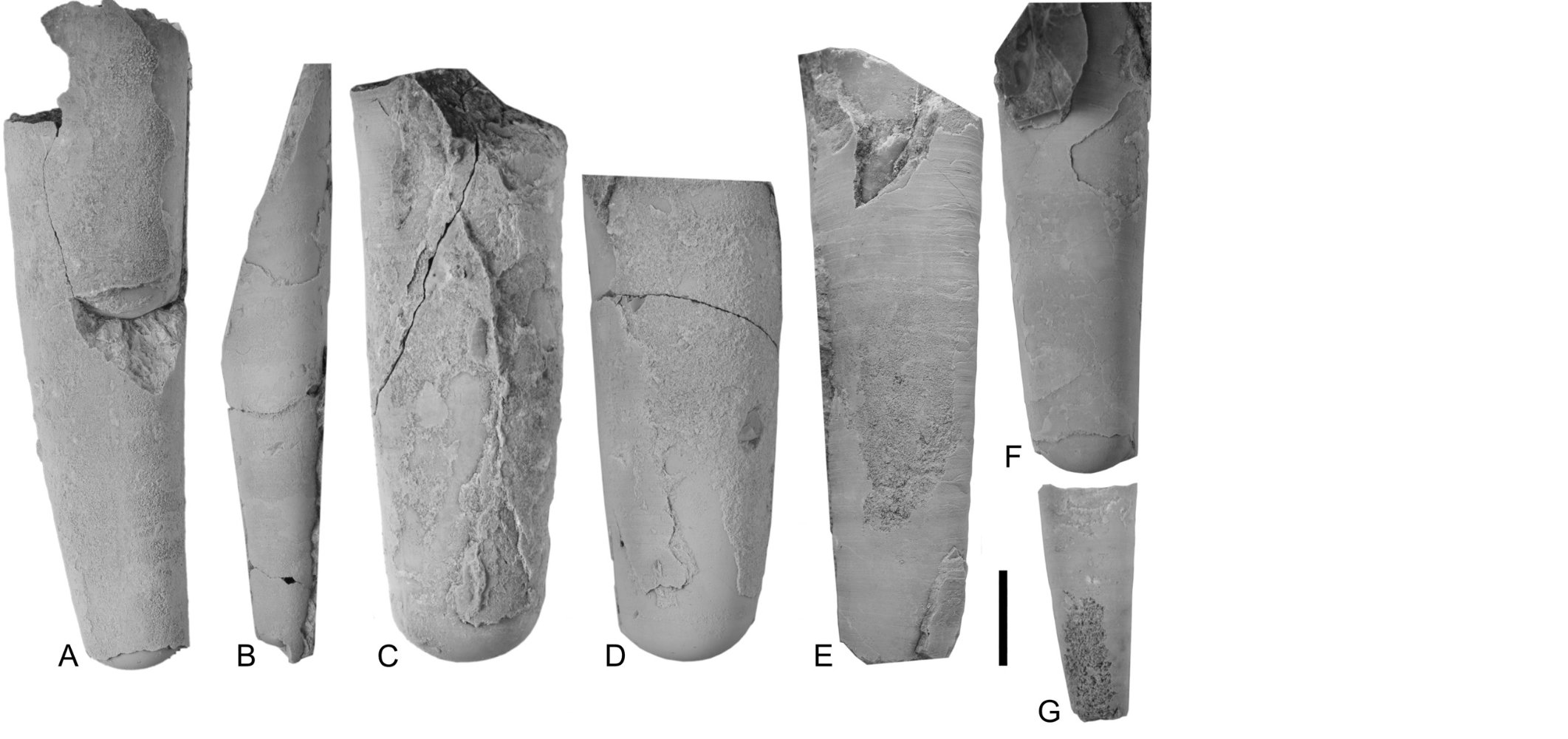
Source: Kröger & Pohle 2021, European Journal of Taxonomy.Maghriboselache Klug, Coates, Frey, Greif, Jobbins, Pohle, Lagnaoui, Bel Haouz & Ginter, 2023
A vertebrate for a change, a cladoselachian (Symmoriiformes, Holocephali, Chondrichthyes) from the Late Devonian. Link
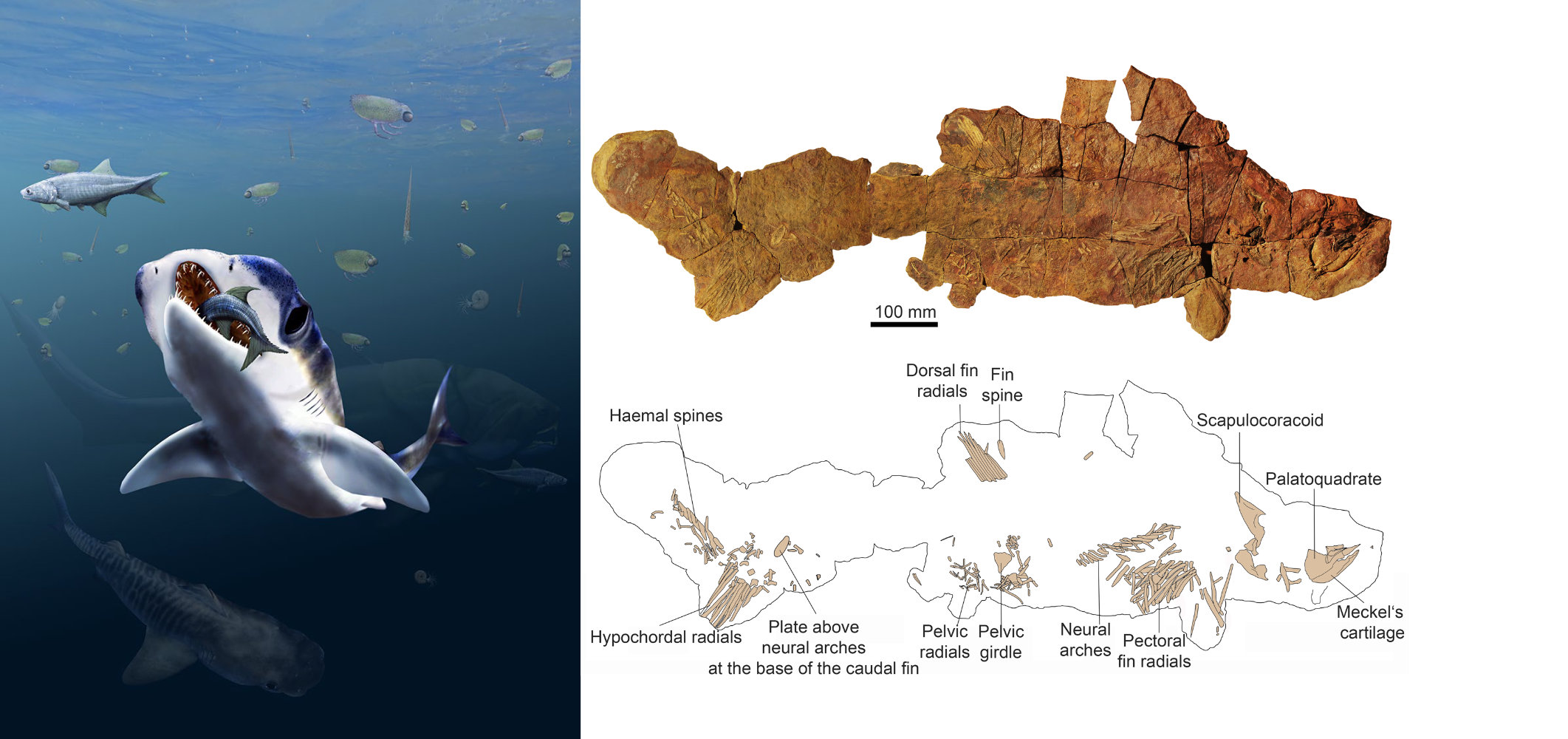
Source: Klug et al. 2023, Swiss Journal of PalaeontologyTicinoteuthis Pohle & Klug, 2024
A stem coleoid resembling the enigmatic Mojsisovicsteuthis, with an elliptical, slowly expanding phragmocone. Link
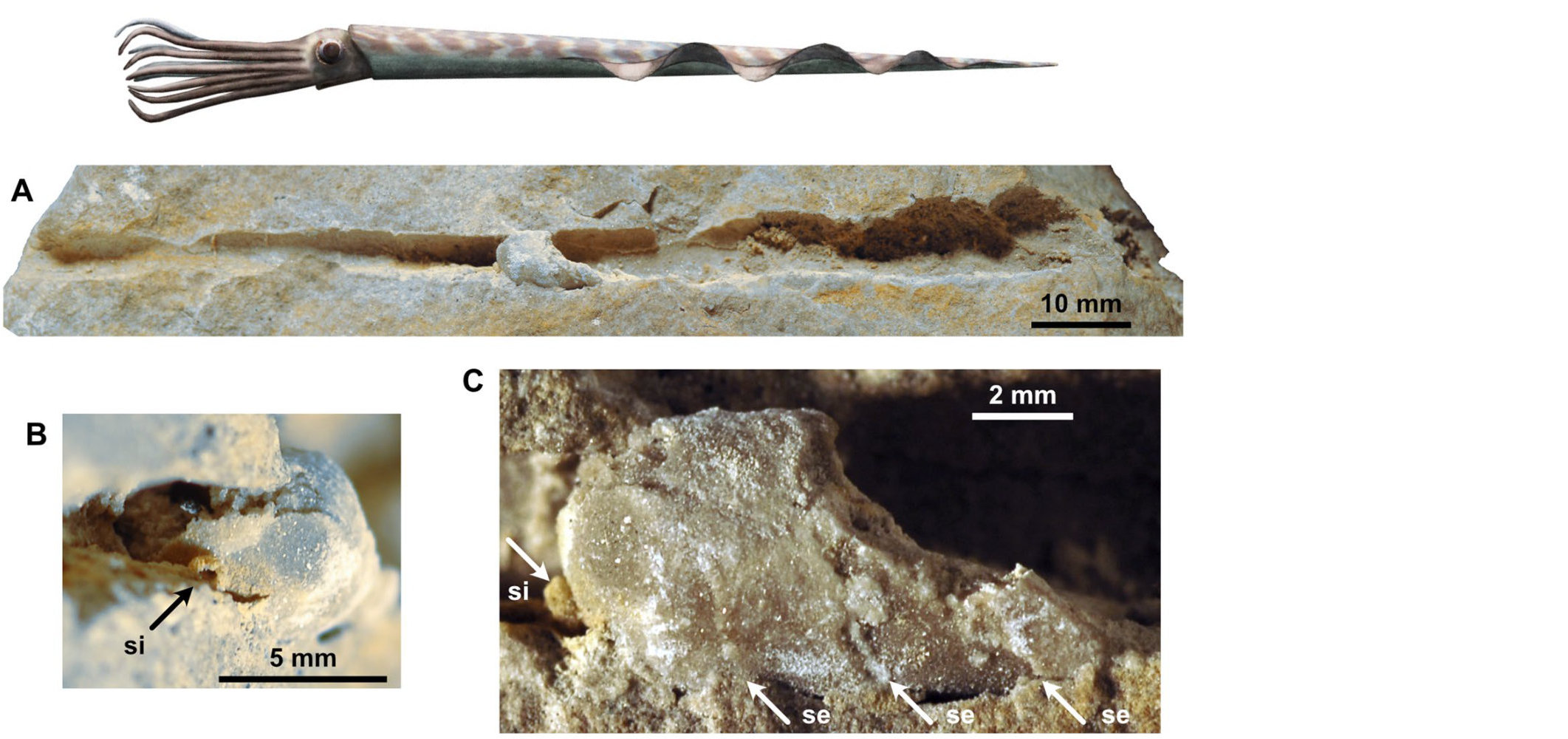
Source: Pohle & Klug 2024, Swiss Journal of Palaeontology.
Species
Aphyctoceras friesenbichlerae Pohle & Klug, 2018
A rutoceratid (Oncoceratida, Multiceratoidea, Cephalopoda) with distinctive ornamentation from the Eifelian (Middle Devonian) of Morocco, named after the most important person in my life. LinkAstoceras floweri Pohle & Klug, 2018
Probably a representative of the little known Sichuanoceratidae (Orthoceratida, Orthoceratoidea, Cephalopoda) from the Emsian (Early Devonian) of Morocco, named in honour of probably the most prolific researchers of nautiloid Palaeontology LinkGeidoloceras hebeiseni Pohle & Klug, 2018
One of the many straight-shelled cephalopods from the Pragian (Early Devonian) of Morocco. This one belongs to the Pseudorthoceratidae (Pseudorthoceratida, Orthoceratoidea, Cephalopoda) and is named after a preparator at the Palaeontological Institute in Zurich. LinkInfundibuloceras kroegeri Pohle & Klug, 2018
Another orthoceratid (Orthoceratida, Orthoceratoidea, Cephalopoda), from the Emsian (Middle Devonian) of Morocco, with very long chambers and long funnel-shaped septal necks. Named after my colleague, co-supervisor of my PhD thesis and one of the best experts on early Palaeozoic cephalopods LinkMesonaedyceras obliquum Pohle & Klug, 2018
Type species of a new genus (see above). A naedyceratid (Oncoceratida, Multiceratoidea, Cephalopoda) from the Eifelian (Middle Devonian) of Morocco. Note that this species is incorrectly spelled as “M. laterobliquum in the abstract of the paper, an overlooked remnant of an earlier version of the manuscript. LinkPachtoceras laghdadense Pohle & Klug, 2018
A potential member of the Poterioceratidae (Oncoceratida, Multiceratoidea, Cephalopoda; the family-level classification of Devonian oncoceratids is a bit chaotic) from the Givetian (Middle Devonian) of Morocco. It is probably the same species that is commonly found in pairs, indicating their semelparous lifecycle (i.e., death shortly after reproduction) Link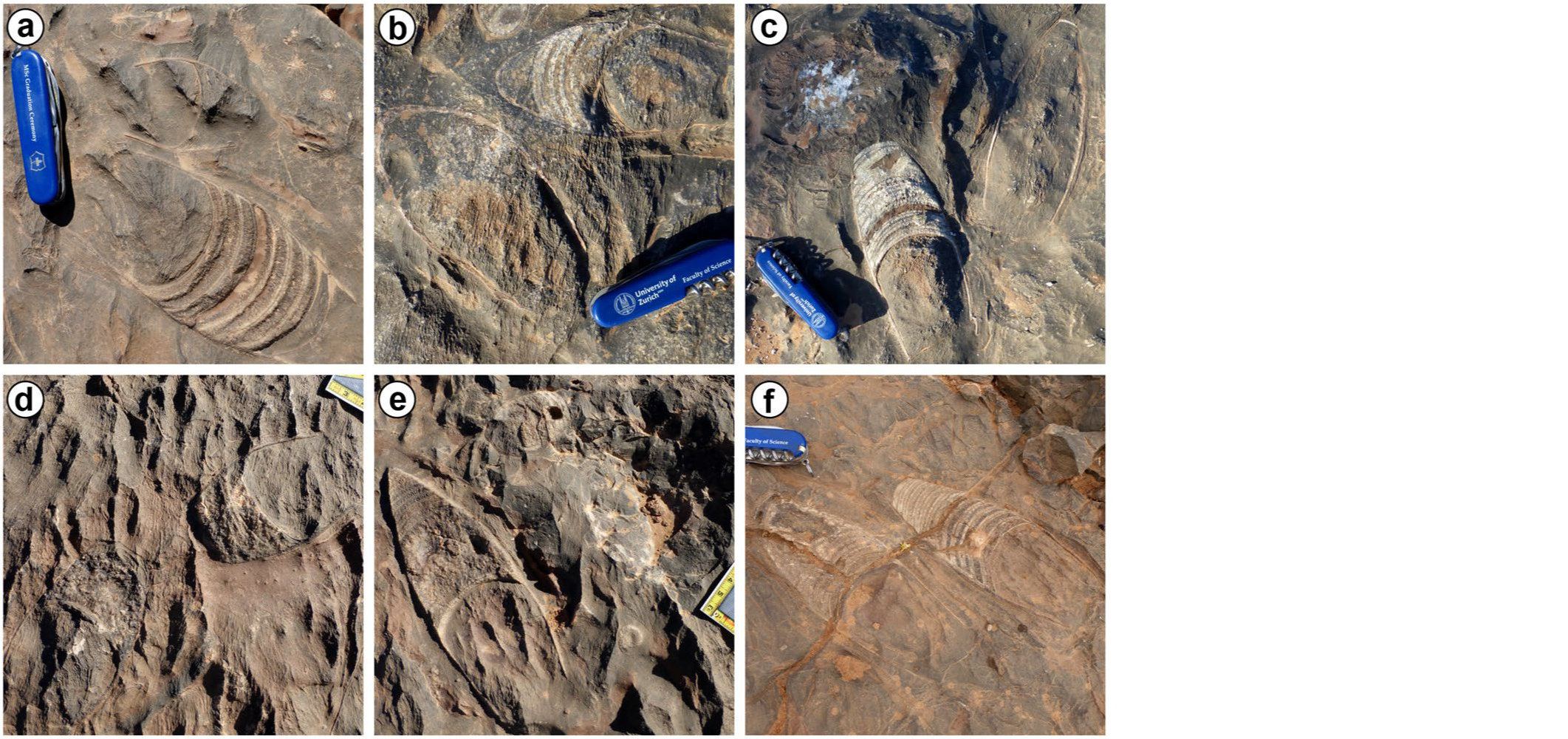 Source: Pohle et al. 2020, Scientific Reports.
Source: Pohle et al. 2020, Scientific Reports.Pseudendoplectoceras angustum Pohle & Klug, 2018
A small species from the Pragian (Early Devonian) of Morocco, currently classified within the Phragmoceratidae (Discosorida, Multiceratoidea, Cephalopoda). LinkSubormoceras asymmetricum Pohle & Klug, 2018
A slender pseudorthoceratid (Pseudorthoceratida, Orthoceratoidea, Cephalopoda) with peculiarly shaped septal necks, from the Pragian (Early Devonian) of Morocco. LinkSubtheoceras striatum Pohle & Klug, 2018
Type species of a new genus (see above). Another orthoceratid (Orthoceratida, Orthoceratoidea, Cephalopoda) from the Pragian (Early Devonian) of Morocco. LinkBasiloceras david Pohle, Klug & Haas, 2019
One of two species of a new genus (see above) belonging to the Acleistoceratidae (Oncoceratida, Multiceratoidea, Cephalopoda), from the Eifelian (Middle Devonian) of Morocco. This species is much smaller than the type species, which is why we named it David. LinkBasiloceras goliath Pohle, Klug & Haas, 2019
This is the type species of the same genus as the above species and one of the largest oncoceratids ever recorded, which is why we decided to name it Goliath. It is an acleistoceratid (Oncoceratida, Multiceratoidea, Cephalopoda), probably from the Eifelian (Middle Devonian; note that we stated Givetian as its age in the original publication, but we now have reason to believe that it is actually slightly older, as additional specimens have been found). LinkRhynchorthoceras yizanense Fang in Fang, Pohle, Kröger, Aubrechtová, Burrett, Zhang & Zhang, 2021
This species belongs to the Sinoceratidae (Lituitida, Orthoceratoidea, Cephalopoda) and some specimens have beautifully preserved conch ornamentation consisting of distinct sinuous growth lines. It comes from the Sandbian (Late Ordovician) of South China. LinkSinoceras complexum Fang in Fang, Pohle, Kröger, Aubrechtová, Burrett, Zhang & Zhang, 2021
A straight-shelled member of the Sinoceratidae (Lituitida, Orthoceratoidea, Cephalopoda) with comparatively long septal necks, from the Katian (Late Ordovician) of South China. LinkTyrioceras longicameratum Fang in Fang, Pohle, Kröger, Aubrechtová, Burrett, Zhang & Zhang, 2021
The first record of this sinoceratid (Lituitida, Orthoceratoidea, Cephalopoda) genus from Asia, from the Katian of South China LinkBactroceras fluvii Kröger & Pohle, 2021
A bactroceratid (Rioceratida, Orthoceratoidea, Cephalopoda) with relatively wide siphuncle from the Dapingian (Middle Ordovician) of Spitsbergen. LinkButtsoceras buldrebreenense Kröger & Pohle, 2021
This species is unique within this genus of the Troedsonellidae (Dissidoceratida, Orthoceratoidea, Cephalopoda) in that it has an elliptically compressed cross section. LinkCycloplectoceras hinlopense Kröger & Pohle, 2021
A strongly ribbed member of the Tarphyceratidae (Tarphyceratida, Multiceratoidea, Cephalopoda), from the Floian (Early Ordovician) of Spitsbergen. LinkCyclostomiceras profilstrandense Kröger & Pohle, 2021
A weakly ornamented member of this genus belonging to the Cyclostomiceratidae (Ellesmeroceratida?, Multiceratoidea, Cephalopoda) from the Floian (Early Ordovician) of Spitsbergen. LinkDeltoceras beluga Kröger & Pohle, 2021
A tarphyceratid or estonioceratid (Tarphyceratida, Multiceratoidea, Cephalopoda) with a relatively high whorl cross section from the Floian (Early Ordovician) of Spitsbergen. LinkEosomichelinoceras borealis Kröger & Pohle, 2021
A member of the Baltoceratidae (Orthoceratida, Orthoceratoidea, Cephalopoda) with eccentric siphuncle and curved early ontogenetic stage, from the Floian (Early Ordovician) of Spitsbergen. LinkEthanoceras solitudines Kröger & Pohle, 2021
Type species of a new genus (see above). A rioceratid (Rioceratida, Orthoceratoidea, Cephalopoda) from the Floian (Early Ordovician) of Spitsbergen. LinkHemichoanella occulta Kröger & Pohle, 2021
This species was difficult to place, as it also shows similarities with some species of Catoraphiceras, Notocycloceras, and Anthoceras. We placed it in the Cyptendoceratidae (Dissidoceratida, Orthoceratoidea, Cephalopoda), and it occurs in the Floian (Early Ordovician) of Spitsbergen. LinkHinlopoceras tempestatis Kröger & Pohle, 2021
Type species of a new genus (see above). A rioceratid (Rioceratida, Orthoceratoidea, Cephalopoda) from the Floian (Early Ordovician) of Spitsbergen. LinkHinlopoceras venti Kröger & Pohle, 2021
Another species of the same genus as the preceding (Rioceratida, Orthoceratoidea, Cephalopoda) from the Floian (Early Ordovician) of Spitsbergen, mainly differing in its conch ornamentation. LinkLawrenceoceras ebenus Kröger & Pohle, 2021
A cyrtocone with elliptically depressed cross section, differing from its congeners in its conch ornamentation. This one is a representative of the Bassleroceratidae (Ellesmeroceratida?, Multiceratoidea, Cephalopoda) from the Floian (Early Ordovician) of Spitsbergen. LinkLawrenceoceras larus Kröger & Pohle, 2021
A member of the same genus as above (Ellesmeroceratida?, Multiceratoidea, Cephalopoda), but more slender than other species. Also from the Floian (Middle Ordovician) of Spitsbergen. LinkLitoceras profilbekkenense Kröger & Pohle, 2021
This one is a member of the Trocholitidae, (Tarphyceratida, Multiceratoidea, Cephalopoda) and may represent a morphological and stratigraphic link between Trocholitoceras and Litoceras, both being coiled cephalopods with relatively wide whorls and central to dorsal siphuncles. This species is from the Floian (Early Ordovician) of Spitsbergen. LinkNyfrieslandoceras bassleroceroides Kröger & Pohle, 2021
Type species of a new genus (see above). A phthanoncoceratid (Oncoceratida, Multiceratoidea, Cephalopoda) from the Floian (Early Ordovician) of Spitsbergen. LinkOlenidslettoceras farmi Kröger & Pohle, 2021
Type species of a new genus (see above). A phthanoncoceratid (Oncoceratida, Multiceratoidea, Cephalopoda) from the Floian (Early Ordovician) of Spitsbergen. LinkProtocycloceras minor Kröger & Pohle, 2021
A small member of this distinctly annulated genus that was long seen as the type genus of its own family Protocycloceratidae, but we reassigned it to the Troedsonellidae (Dissidoceratida, Orthoceratoidea, Cephalopoda) instead, based on the presence of diaphragms and calcaereous linings within the siphuncle. It is from the Floian (Early Ordovician) of Spitsbergen. LinkProterocameroceras valhallfonnense Kröger & Pohle, 2021
From this species, no endocones were preserved, and therefore, its placement within this genus and even order and subclass (Proterocameroceratidae, Endoceratoidea, Cephalopoda) are somewhat uncertain. However, it agrees with other members of this group in being an orthocone with a very large siphuncle and short septal necks. It is from the Floian (Early Ordovician) of Spitsbergen. LinkSvalbardoceras sterna Kröger & Pohle, 2021
Type species of a new genus (see above). A rioceratid (Rioceratida, Orthoceratoidea, Cephalopoda) from the Floian (Early Ordovician) of Spitsbergen. LinkSvalbardoceras skua Kröger & Pohle, 2021
Another species of the same genus as the previous one (Rioceratida, Orthoceratoidea, Cephalopoda) from the Floian (Early Ordovician) of Spitsbergen, differing in having a circular rather than a elliptically compressed cross section. LinkMaghriboselache mohamezanei Klug, Coates, Frey, Greif, Jobbins, Pohle, Lagnaoui, Bel Haouz & Ginter, 2023
Type species of a new genus (see above). A cladoselachian (Symmoriiformes, Holocephali, Chondrichthyes) from the Famennian (Late Devonian) of Morocco. LinkEllesmeroceras humahuacaensis Cichowolski, Vaccari, Pohle, Morón-Alfonso, Vaucher & Waisfeld, 2023
A tiny ellesmeroceratid (Ellesmeroceratida, stem Cephalopoda), the oldest known cephalopod from South America, from the early Tremadocian (Early Ordovician) of Argentina. LinkSinoeremoceras marywadeae Pohle, Jell & Klug, 2024
A plectronoceratid (Plectronoceratida, stem Cephalopoda), known from abundant well-preserved material, revealing the complex 3D-structure of the siphuncle, which provided the basis for a major revision of the Plectronoceratida. From the (unnamed) Stage 10 (Furongian, late Cambrian) of Queensland, Australia. Link
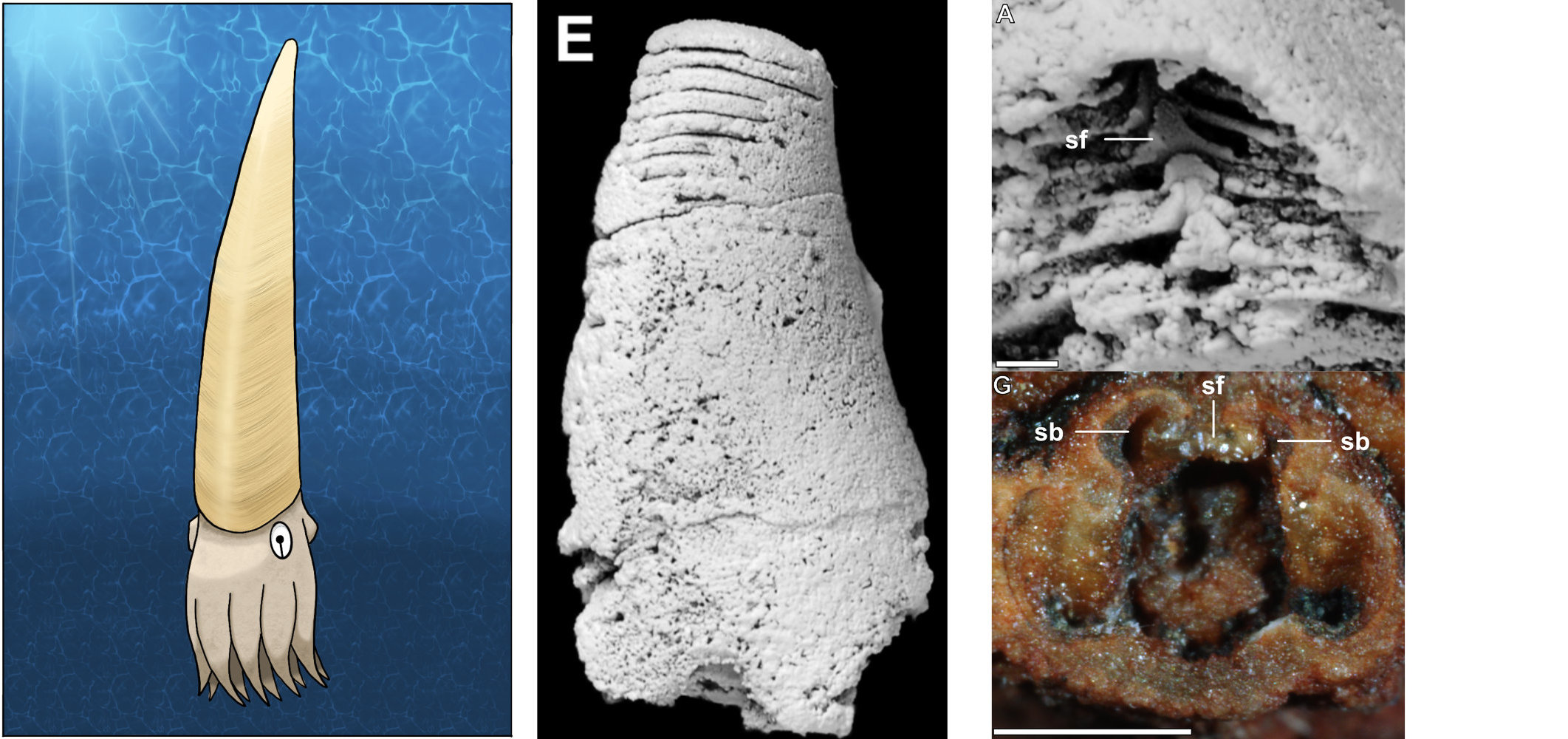
Source: Pohle et al. 2024, PeerJ.Ticinoteuthis chuchichaeschtli Pohle & Klug, 2024
Type species of a new genus (see above). Named after a famous Swiss shibboleth (“Chuchichäschtli”), meaning small kitchen cupboard, because it was stored in a drawer in Zurich for many years. From the Anisian (Middle Triassic) of Ticino, Switzerland. Link
